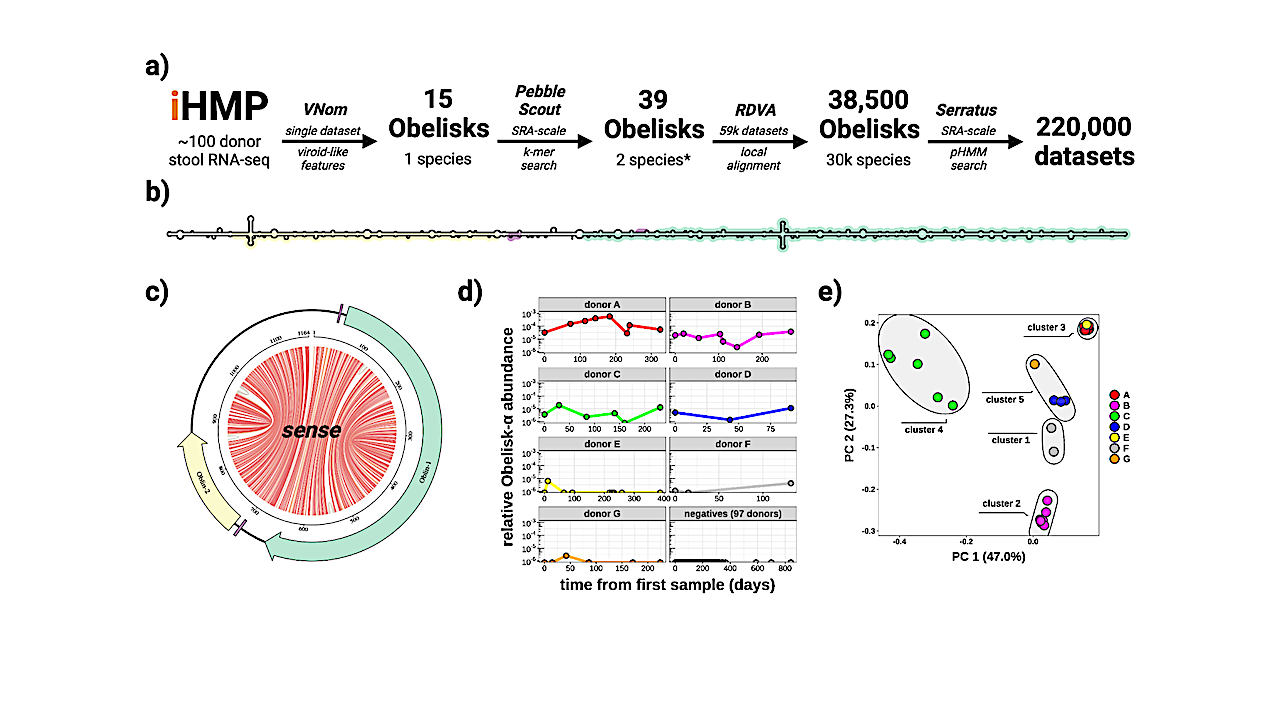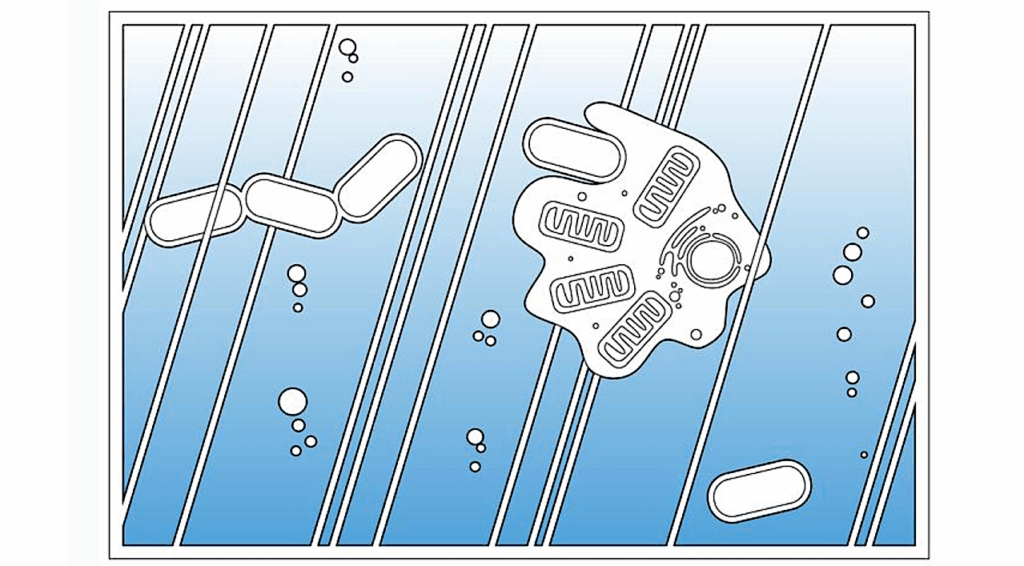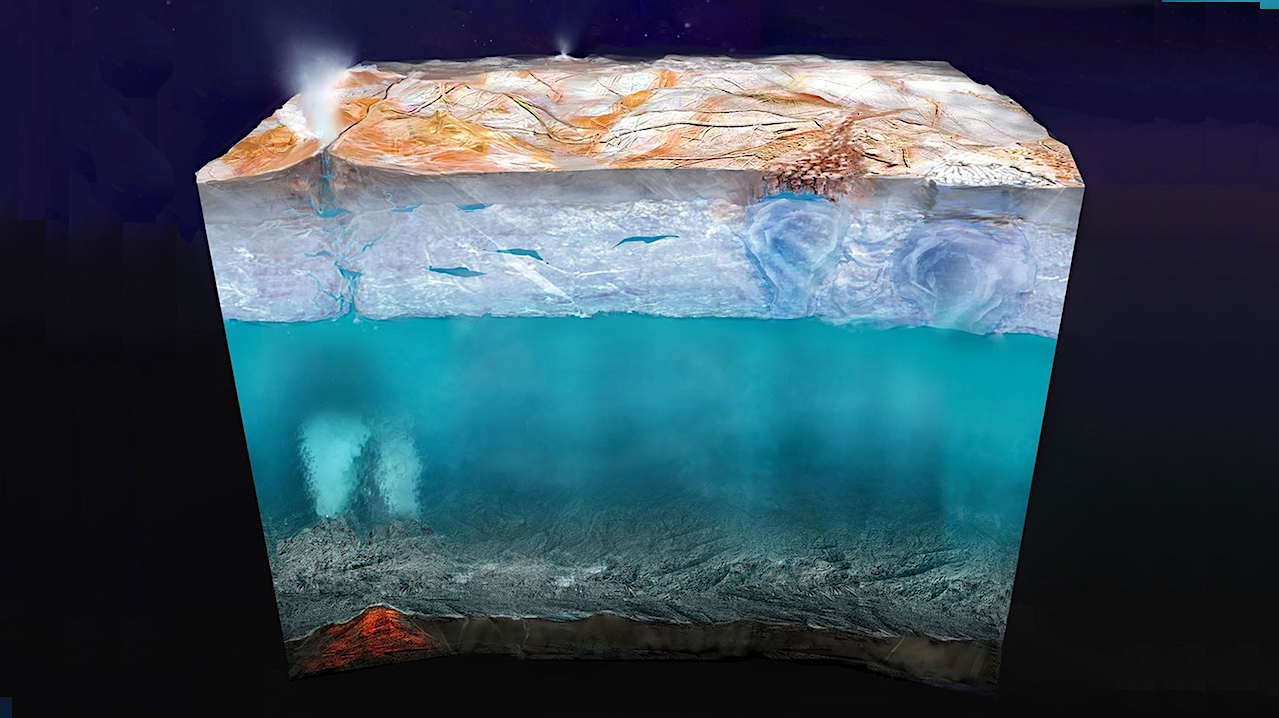Now Reading: Obelisks: Newly-Discovered Viroid-like Colonists Of Human Microbiomes
-
01
Obelisks: Newly-Discovered Viroid-like Colonists Of Human Microbiomes
Obelisks: Newly-Discovered Viroid-like Colonists Of Human Microbiomes


Obelisk alpha has a predicted extensive secondary structure and appears to colonise and speciate within the human gut a) overview of the iterative approach taken in Obelisk discovery, (see methods) b) schematic of the predicted sense consensus secondary structure derived from all non-redundant, 1164 nt Obelisk-ɑs found using SRA-scale k-mer matching (PebbleScout). Predicted open reading frames (ORFs) 1 and 2 (green/yellow), and Shine-Delgarno sequences (purple) shown, c) “jupiter” plot of Obelisk-ɑ coloured as in b), chords illustrate predicted basepairs (basepair probabilities grey, 0.1, to red, 1.0) d) Obelisk-ɑ relative read abundance for six donors (A-G); sequence data from in Lloyd-Price et al., 2019 and time in days from first sample. e) Principal component analysis of sequence variation seen in Obelisk-ɑ reads in Lloyd-Price et al., 2019 (the initial iHMP dataset), grouped by k-means clustering with 5 centres, coloured as in d). biorxiv via PubMed
Editor’s note: researchers were surprised recently when an unexpected and rather novel biological structure was found inside the cells of the human gut. Nicknamed “obelisks” due to their shape, these are virus-like structures with their own small genomes composed of RNA loops with genetic sequences- many of which are unlike anything yet to be discovered in other terrestrial life forms. The origin of these Obelisks among the known range viruses, viroids, and other known small genetic entities is presently uncertain. They are common across all humans on Earth. This does go to show that there are unknown and unexpected aspects to Earth life yet to be discovered. This should also serve as a rememder when we begin to search for – and try to understand – life on other worlds.
Here, we describe the “Obelisks,” a previously unrecognised class of viroid-like elements that we first identified in human gut metatranscriptomic data. “Obelisks” share several properties: (i) apparently circular RNA ∼1kb genome assemblies, (ii) predicted rod-like secondary structures encompassing the entire genome, and (iii) open reading frames coding for a novel protein superfamily, which we call the “Oblins”.
We find that Obelisks form their own distinct phylogenetic group with no detectable sequence or structural similarity to known biological agents. Further, Obelisks are prevalent in tested human microbiome metatranscriptomes with representatives detected in ∼7% of analysed stool metatranscriptomes (29/440) and in ∼50% of analysed oral metatranscriptomes (17/32).
Obelisk compositions appear to differ between the anatomic sites and are capable of persisting in individuals, with continued presence over >300 days observed in one case. Large scale searches identified 29,959 Obelisks (clustered at 90% nucleotide identity), with examples from all seven continents and in diverse ecological niches. From this search, a subset of Obelisks are identified to code for Obelisk-specific variants of the hammerhead type-III self-cleaving ribozyme.
Lastly, we identified one case of a bacterial species (Streptococcus sanguinis) in which a subset of defined laboratory strains harboured a specific Obelisk RNA population. As such, Obelisks comprise a class of diverse RNAs that have colonised, and gone unnoticed in, human, and global microbiomes.
Viroid-like colonists of human microbiomes, biorxiv via PubMed
Astrobiology, Genomics,
Stay Informed With the Latest & Most Important News
Previous Post
Next Post
-
 012024 in Review: Highlights from NASA in Silicon Valley
012024 in Review: Highlights from NASA in Silicon Valley -
 02Panasonic Leica Summilux DG 15mm f/1.7 ASPH review
02Panasonic Leica Summilux DG 15mm f/1.7 ASPH review -
 03How New NASA, India Earth Satellite NISAR Will See Earth
03How New NASA, India Earth Satellite NISAR Will See Earth -
 04And Thus Begins A New Year For Life On Earth
04And Thus Begins A New Year For Life On Earth -
 05Astronomy Activation Ambassadors: A New Era
05Astronomy Activation Ambassadors: A New Era -
06SpaceX launch surge helps set new global launch record in 2024
-
 07Space Force plans new ‘Futures Command’ amid pressure to speed up modernization
07Space Force plans new ‘Futures Command’ amid pressure to speed up modernization





















